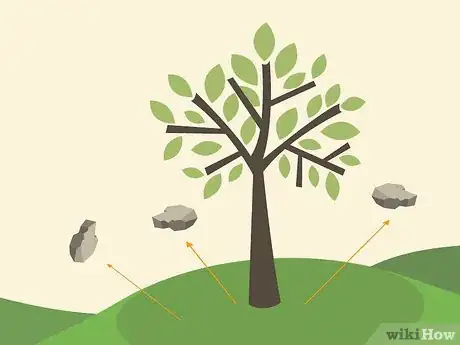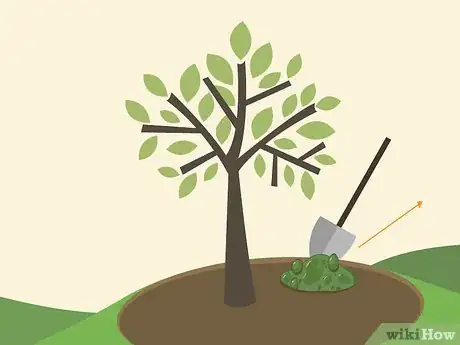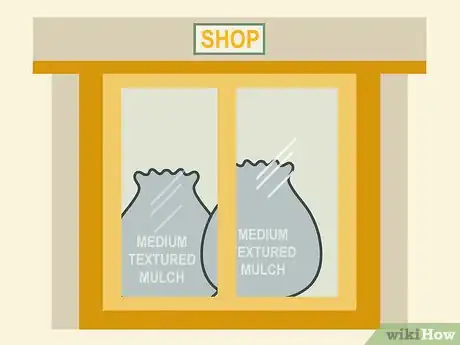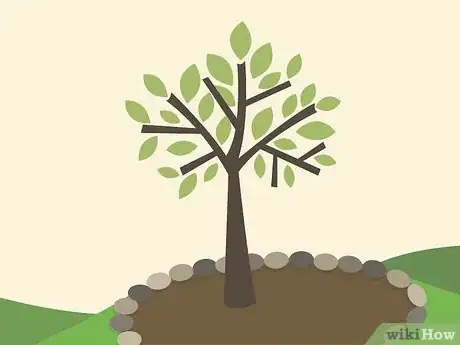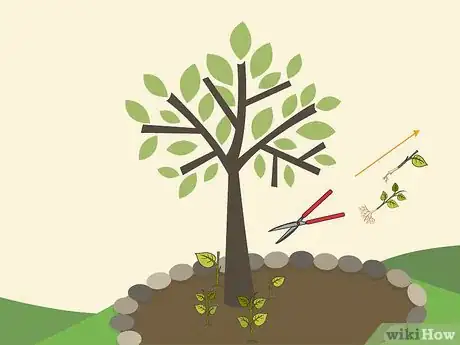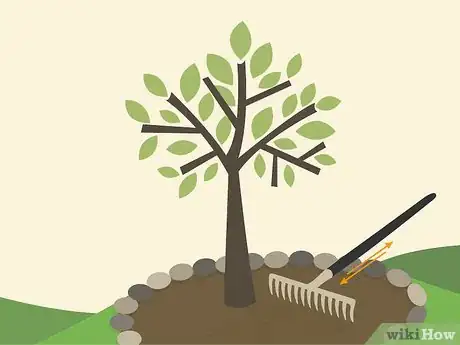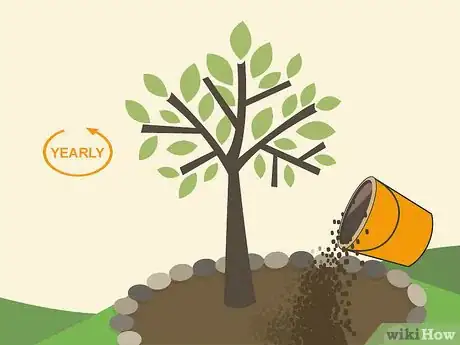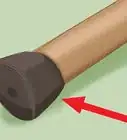This article was co-authored by Lauren Kurtz. Lauren Kurtz is a Naturalist and Horticultural Specialist. Lauren has worked for Aurora, Colorado managing the Water-Wise Garden at Aurora Municipal Center for the Water Conservation Department. She earned a BA in Environmental and Sustainability Studies from Western Michigan University in 2014.
This article has been viewed 204,148 times.
Putting mulch around a tree makes lawns more attractive, controls weeds, and helps maintain soil moisture. However, if you apply mulch incorrectly, you can stimulate the growth of fungus, attract insects, and starve the tree's roots of oxygen. Luckily, properly mulching is easy as long as you follow the right steps.
Steps
Removing an Existing “Mulch Volcano”
-
1Shovel away old mulch, dirt, and rocks. Shovel away all the old mulch, debris, and rocks so that you can see the tree trunk. A "mulch volcano” occurs when mulch is piled up year after year on the base of a tree. Mulch piled up at the base of a tree is detrimental and starves the roots of needed oxygen.[1]
-
2Cut up-growing roots with pruners. Up-growing roots can wrap around the base of the tree and kill it over time. If you notice any roots growing upward around the tree as you clear away old mulch, cut them away. Up-growing roots are a sign that the tree is starved for oxygen.Advertisement
-
3Remove grass and other weeds with a spade or gardening claw. Scrape the area around the base of the tree to get rid of any weeds or grass. Once you shovel away excess mulch, dirt, and rocks, you should see the primary root flare around the base of the tree.
- Mulch will act as a natural weed-barrier.
- Roll-out weed barriers, which are also called landscaping fabric, starve the tree of oxygen and compact the soil underneath -- you should avoid using them.[2]
Adding a Proper Mulch Bed
-
1Purchase a medium-textured mulch. Fine textured mulch gets compacted and can starve your tree's roots of oxygen. Coarse mulch is too porous to maintain adequate water. A medium-textured mulch will hold water and won't starve the tree's roots of oxygen.[3]
- Organic mulches include wood chips, bark, pine needles, leaves, and compost mixes.
- If you're unsure of how much mulch you'll need, type "mulch calculator" into a search engine to find online tools that will help you calculate the amount. See, for instance, https://schneidertree.com/mulch-calculator/.
-
2Spread mulch in a 4–5 feet (1.2–1.5 m) diameter around the tree. Lay down a thin layer of mulch around the tree. The mulch should not touch the tree itself. Leave 1–2 inches (2.5–5.1 cm) of space between the base of the tree and the mulch.[4]
- You can lay mulch up to an 8 feet (2.4 m) diameter before it stops being useful.
-
3Continue laying down mulch until it's 2–4 inches (5.1–10.2 cm) deep. Keep layering the mulch around the tree until it's the proper depth. The mulch shouldn't be piled up in a hill and should be spread level around the tree.[5]
-
4Create a mulch-bed barrier with stones or extra mulch. You can pile extra mulch around the edges of your mulch bed to create a barrier that will prevent the mulch from washing away when it rains. You can also place rocks around the mulch bed to create a barrier.[6]
Maintaining the Mulch Bed
-
1Pull or kill weeds that grow out of the mulch. Mulch is meant to act as a barrier for weeds and grass. You should pull any weeds or grass that grow out of the mulch bed throughout the year to prevent future growth. You can also use an herbicide, which is a chemical weed killer, around your tree to prevent grass and weeds from growing in your mulch.
- If you use an herbicide, make sure that it's safe to use around trees.
-
2Rake the mulch occasionally to prevent it from getting packed down. Compacted mulch prevents oxygen from passing through and can starve your tree's roots. If you notice that the mulch has been compacted down due to rainfall or people walking over it, make sure to occasionally loosen it up by raking it.
-
3Replenish the mulch once a year. Make it a point to replenish the mulch around the tree once a year. This will prevent weeds, provide essential nutrients, and help with the tree's drainage.[7]
Things You'll Need
Preparing the Area
- Shovel
- Pruning shears
Laying Down Mulch
- Medium-textured mulch
- Shovel
Maintaining the Mulch Bed
- Weed killer (optional)
- Rake
References
- ↑ https://youtu.be/fI12XNNqldA?t=12s
- ↑ http://www.bigblogofgardening.com/the-landscape-fabric-weed-barrier-myth/
- ↑ http://www.mortonarb.org/trees-plants/tree-and-plant-advice/horticulture-care/mulching-trees-and-shrubs
- ↑ http://www.mortonarb.org/trees-plants/tree-and-plant-advice/horticulture-care/mulching-trees-and-shrubs
- ↑ https://www.arborday.org/trees/tips/mulching.cfm
- ↑ https://www.todayshomeowner.com/how-to-keep-mulch-from-floating-out-of-flower-beds/
- ↑ https://www.whiteflowerfarm.com/watering-mulching-fertilizing
About This Article
To mulch around a tree, start by shoveling away old mulch, dirt, grass, weeds, or rocks so you can see the tree trunk. Next, cut up-growing roots with pruners to allow the tree to get enough oxygen. Once the area is cleared, buy a medium-textured mulch, which will hold water and won’t starve the tree’s roots of oxygen. Then, spread a 2-4 inch layer of mulch in a 4-5 feet diameter around the tree, but make sure to leave a 1-2 inch space between the mulch and the base of the tree itself. For more tips from our Horticultural reviewer, including how to maintain a mulch bed, keep reading!
